Live Blogged! Please excuse typos and awkward wordings
I’m sitting in the opening session of the NAACE conference in Torquay, England. On my way over to the Riviera Convent Centery, I ran into Ewan Macintosh, which was a wonderful surprise. The first person we saw, entering the hall, was Terry Freedman. So I’m among friends, and making new ones.
The keynote is being delivered via Second Life, and actually quite effectively. This very intriging show is being delivered by Jim Knight, Minister of State for Schools and Learners,. There is a video screen in the middle of the virtual hall for viniettes about embedding ICT. The only weakness is that there are only three people in the virtual audience. That said, this took a lot of courage.
In one of the viniettes, someone predicted that in 10 years, we’ll have schome, a blend of school and home. The speaker was logged out for a moment, but returned to inteview the manager of a learning space that is being used to acquaint teachers with the possibilities of Second Life.
You can learn more about the virtual environment where this keynote address from the Learn 4 Life space. Here’s a blog post about the keynote.
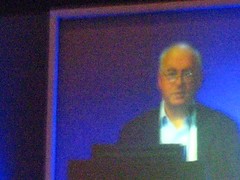 The current speaker is Professor John Naughton, and he is drawing extensively from Niel Postman. He’s making an interesting point about our shift from information scarce environments to information abundant environment. He says that our mistake has been to think of information as an economy. It’s why, with the rise of broadcast TV, it was predicted that TV would wipe out Radio. He says that it may be much more helpful to think of the information environment as an eco-system. It does a much better job of handling the complexities of the information landscape.
The current speaker is Professor John Naughton, and he is drawing extensively from Niel Postman. He’s making an interesting point about our shift from information scarce environments to information abundant environment. He says that our mistake has been to think of information as an economy. It’s why, with the rise of broadcast TV, it was predicted that TV would wipe out Radio. He says that it may be much more helpful to think of the information environment as an eco-system. It does a much better job of handling the complexities of the information landscape.
He says…
A new organism has invated the ecosystem, and the older organisms are having to adapt.
Noughton mentions a presentation he saw for the NY Library Council where Lee Rainie describe six new realities for today’s youngsters. I found the powerpoint used by Rainie to get the correct text of hte realities.
6 new realities in the life of digital natives and what they mean for them and for you
- Reality 1
Media and gadgets are ubiquitous parts of everyday life
- Reality 2
New gadgets allow them to enjoy media and carry on communication anywhere
- Reality 3
The internet is at the center of the revolution
- Reality 4
Multi-tasking is a way of life – and people live in a state of “continuous partial attention”
- Reality 5
Ordinary citizens have a chance to be publishers, movie makers, artists, song creators, and story tellers
- Reality 6
Everything will change even more in coming yearsRainie, Lee. “Digital Natives.” Metro New York Library Council. Brooklyn Museum of Art, Brooklyn. 27 Oct 2006.
“The Internet is not a fire hose. It’s a bean stalk.” A useful visual.
Technorati Tags: warlick education technology ict naace08 naace2008 naace

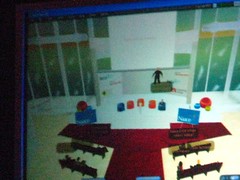
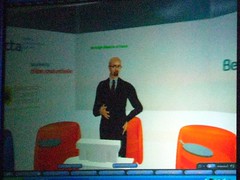

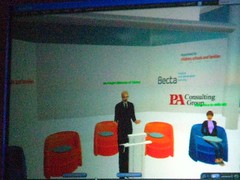
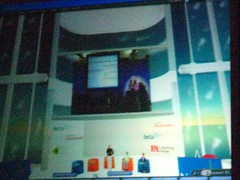
What an amazing overview — my students and I have often discussed how the lines between home and school are blurring significantly, particularly when global collaborative projects become part of the classroom. Now that they twitter from cell phones and can live stream video or send photos from cell phones or record podcasts via cell, it has blurred even more. Great conference. Tell Terry I said “hi.”
Was this recorded by any chance. Just interested to see how the keynote was done.
Jim Knight, Minister of State for Schools and Learners, must be one heck of a risk taker, awesome. I echo Brian’s thoughts I would love to know more about how it was done. Good luck on your presentations, but also make time for fun!
I agree! My immediate impression what the this took a lot of courage. Technically, I’m not sure how it was done. I got the impression that what we saw was being driven by someone in the back of the room. There was a lot of zooming in and out, and selecting things from inventory.
One of the SL participants was physically in an airport somewhere. But there were folks who are not able to come in on que. This sort of thing would have to be precisely organized and choreographed. ..or not. Sometimes it’s better to go with the flow.
I impressed myself at being able to find the powerpoint presentation used by Lee Rainie in the address remembered by Naughton.
I disagree:
The flow of input is more continuous, and the volume of input is generally greater, but people are still doing one thing at a time. Unless you’re Marty McFly.
I thought John Naughton made some interesting points, although his assertion that there is no evidence to show that ICT makes any difference is simply not true. On the subject of Jim Knight, the Education Minister, I think it was amazingly courageous of him to have appeared in Second Life. We were all expecting a video-conference call, so that was very refreshing!
David, thanks so much for sharing!
“Schome” actually already exists – I know because I’ve had the privilege of working with researchers from the U.K.’s Open University on the Schome Park Project (http://schome.open.ac.uk/). I blogged it here:
http://www.ncs-tech.org/?p=970
and also here:
http://www.storyofmysecondlife.com/?cat=41
These kids (and the researchers) are AMAZING. Here’s something they just came up with – for fun – a contest entry for a device of their own design:
http://www.faji.co.uk/sl/SCHOME_satellite.doc
None of these people (other than the adult researchers) have ever even met in real life.
We have a small group of teens from my school working with the Schome kids.
I would be happy to answer anyone’s questions about Schome, but the best person to contact is the project director, Peter Twining: P.Twining@open.ac.uk.
-kj-
I too would like to see a recording of this session – I suspect that the vignette in which the prediction about schome (not school – not home – schome – the education system for the information age) was made came from a Teachers’ TV programme (see http://www.teachers.tv/video/23906 about 4 mins into the programme is a section on virtual worlds).
To find out more about schome check out http://www.schome.ac.uk/